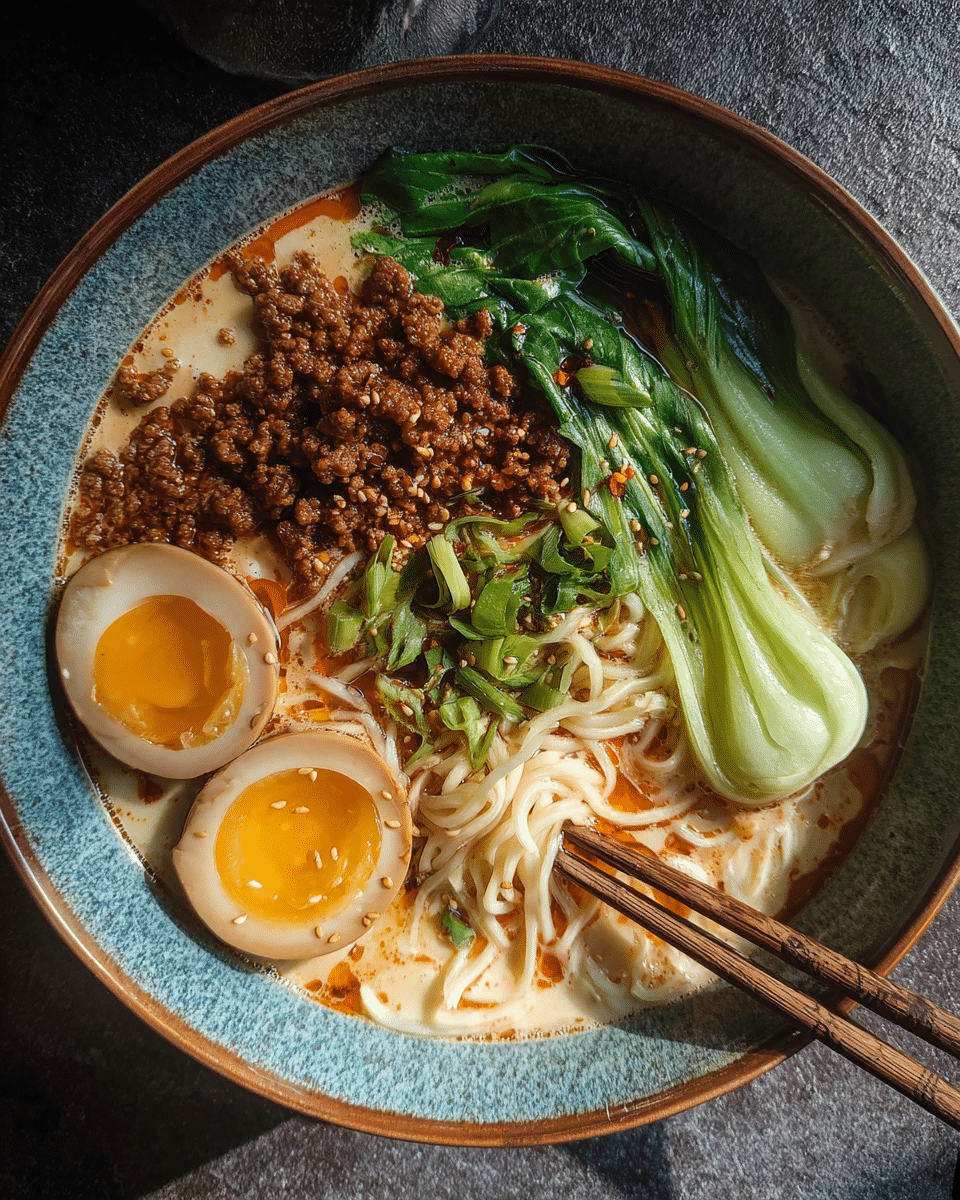The rich flavors of Tantanmen Ramen bring together creamy sesame broth, spicy chilli oil, and savory ground pork, making each spoonful deeply comforting. This Japanese twist on Dan Dan noodles balances bold heat with mellow creaminess for a perfectly satisfying noodle bowl.
It’s an easy recipe that looks gourmet perfect for busy weeknights, cozy weekends, or when you just need a big, warm hug in a bowl. Customizable with veggies, heat levels, and protein choices, it invites you to make it your own. Whether you love a fiery punch or a gentle warmth, this dish delivers.
Full Recipe:
Ingredients:
-
Noodles:
2 servings of noodles (e.g., somen, ramen, or soba) -
Sauce Base:
2 tbsp sesame paste or peanut butter
1 tbsp rice vinegar
2 tbsp soy sauce
1–2 tbsp chilli oil (adjust to taste) -
Pork Topping:
200g ground pork
1 tbsp doubanjiang (or gochujang as substitute)
1 tbsp Chinese cooking wine (optional)
1 tbsp light soy sauce
1 tsp minced garlic
1 tsp grated ginger -
Soup Base:
500ml chicken stock
300ml unsweetened soy milk (or oat milk)
1 tbsp chilli oil (optional) -
Veggies & Garnishes:
1–2 heads pak choi
2 ramen eggs (optional)
Chopped spring onions, sesame seeds, extra chilli oil for garnish
Directions:
-
In a pot, bring the chicken stock and soy milk to a gentle simmer.
-
In a separate bowl, whisk together sesame paste, rice vinegar, soy sauce, and chilli oil until smooth.
-
Heat a frying pan and add the pork (no oil needed). Cook while breaking it apart until browned.
-
Stir in garlic, ginger, doubanjiang, soy sauce, and Chinese cooking wine. Cook for 1–2 more minutes and season to taste. Set aside.
-
Cook noodles according to package instructions. Add pak choi during the final minute to blanch. Drain and rinse briefly under cold water.
-
Stir the sesame mixture into the warm broth.
-
Assemble: divide noodles and pak choi between bowls. Pour over hot broth. Top with pork, ramen egg, and garnishes.
Prep Time: 5 minutes
Cooking Time: 15 minutes
Total Time: 20 minutes
Kcal: Approx. 600 kcal (varies by noodle and protein choice)
Servings: 2 servings
Tantanmen Ramen: A Bold and Comforting Japanese Chinese Fusion Dish
In the world of noodle soups, few dishes offer the satisfying complexity of Tantanmen Ramen. Creamy, spicy, savory, and endlessly customizable, this modern Japanese interpretation of the classic Sichuan-style Dan Dan noodles has earned a cult following among ramen lovers and home cooks alike.
Originating as a cross cultural culinary hybrid, Tantanmen combines the signature heat and depth of Chinese Dan Dan Mian with the richness and umami-driven essence of Japanese ramen. The result? A velvety, soul-warming bowl of broth soaked noodles that’s as comforting as it is crave worthy. Whether you’re preparing a quick weeknight dinner or seeking out new flavors to impress dinner guests, Tantanmen Ramen delivers a gourmet experience with surprisingly simple pantry ingredients.
A Brief History: From Sichuan Streets to Tokyo Kitchens
The roots of Tantanmen trace back to Dan Dan Noodles, a Sichuan street food dish that is traditionally served dry or with just a spoonful of sauce. In its original Chinese form, the dish features minced pork, chili oil, Sichuan peppercorns, soy sauce, and preserved vegetables layered over noodles. The heat is unapologetic, the flavors are bold, and the texture is as dynamic as its taste.
When this iconic noodle dish made its way to Japan, chefs began adapting it to suit local palates. The transformation included toning down the mouth numbing Sichuan pepper, adding a creamy broth (often using sesame paste or soy milk), and switching from dry to soupy. Thus, Tantanmen Ramen was born a dish that embraces the best of both culinary traditions while carving out an identity all its own.
Flavor Profile: A Dance of Creaminess, Heat, and Umami
What sets Tantanmen Ramen apart from other ramen varieties is its incredibly rich broth. At the heart of the soup is a sesame or peanut-based paste that delivers deep nuttiness and a silky texture. This is balanced by the spice and fragrance of chili oil, layered with savory soy sauce, and rounded out by chicken or pork stock. The result is a broth that coats the noodles luxuriously, clings to the toppings, and hits every corner of your palate with warmth and satisfaction.
The flavor isn’t all about heat though you can certainly crank it up. The mild sweetness of sesame or peanut butter tempers the spice, while rice vinegar or miso adds gentle acidity. When paired with ground pork sautéed in garlic, ginger, and doubanjiang (spicy fermented bean paste), every spoonful delivers a punch of flavor that’s as nuanced as it is comforting.
Versatility for Modern Home Cooks
One of the reasons Tantanmen has become such a hit in home kitchens is its customizability. While many ramen types can be rigid in their preparation, Tantanmen invites experimentation. You can make it vegetarian or vegan by swapping ground pork with tofu, mushrooms, or plant-based meat, and using vegetable broth in place of chicken stock. The sesame paste can be replaced with natural peanut butter if that’s what’s on hand making it accessible and easy for cooks at all levels.
The noodles themselves can be swapped for whatever you have in the pantry. Traditional ramen noodles work beautifully, but so do soba, udon, or even spaghetti in a pinch. Add-ins like baby spinach, bok choy, mushrooms, corn, or bean sprouts add color and texture without needing extra effort.
And let’s not forget the toppings a marinated ramen egg (ajitsuke tamago), chopped scallions, sesame seeds, nori strips, or even a drizzle of extra chili oil give each bowl a touch of visual appeal and flavor complexity.
Nutritional Highlights
Tantanmen Ramen may taste indulgent, but it can also be surprisingly nutritionally balanced, especially when made at home. The soup base provides protein and healthy fats from sesame or peanut paste, while the broth and noodles contribute energy-giving carbohydrates. If you include lean proteins like pork, tofu, or chicken, the meal becomes more satiating.
By adding green vegetables like pak choi, spinach, or even kale, you boost the fiber, vitamins, and minerals. Swapping traditional wheat noodles for whole-grain or gluten-free alternatives is another way to tailor the dish to different dietary needs.
Using soy milk or oat milk in place of cream or heavy tonkotsu broths also makes the dish lighter while still maintaining its signature creaminess. And because you control the amount of oil and sodium, the homemade version of Tantanmen is far healthier than many restaurant or instant ramen alternatives.
Perfect Pairings and Serving Ideas
Tantanmen Ramen is a standalone star, but you can elevate the meal by pairing it with side dishes that contrast or complement its bold flavors. A crisp Asian cucumber salad with sesame and rice vinegar offers a cooling counterpoint. Light steamed dumplings or gyoza provide a satisfying bite without overpowering the ramen. If you’re serving it as part of a dinner party, small plates like edamame, seaweed salad, or Japanese pickles add variety and texture.
For drinks, a light Japanese lager, sake, or chilled green tea works beautifully. Avoid anything too sweet or heavy, as the dish already has a rich and intense flavor profile.
Why This Recipe Works for Busy Cooks
In an age where time is precious, this 20-minute Tantanmen recipe makes gourmet-level comfort food achievable. It doesn’t rely on long simmers or exotic ingredients just smart layering of pantry staples. Most of the work is done in parallel: simmering broth, cooking pork, boiling noodles. With a few simple cooking techniques and a well-stocked kitchen, you’ll have a steaming bowl of ramen ready in less time than it takes for delivery to arrive.
Even better, the individual components (like the pork topping or broth) can be prepped in advance and stored for up to 3 days in the fridge. This makes Tantanmen a great meal-prep option, allowing for quick assembly even on your busiest weeknights.
Cultural Significance in a Bowl
Tantanmen is more than just a trendy dish it’s a representation of culinary fusion done right. It tells a story of cross-cultural exchange: the migration of Chinese flavors into Japanese kitchens, and the willingness to adapt and reinterpret while maintaining respect for the original. As global cuisine becomes increasingly interconnected, Tantanmen stands out as a beautiful example of how tradition and innovation can coexist.
For many, this bowl of noodles is also a comfort food, associated with warmth, family meals, and moments of relaxation. It’s nourishing not just for the body, but also for the soul the kind of meal that brings people together around the table.
Conclusion:
Tantanmen Ramen is the kind of dish that captures attention with its vibrant appearance and wins hearts with its deep, layered flavors. It’s spicy yet creamy, filling yet balanced, and indulgent yet wholesome when made at home. Its adaptability makes it a favorite among both novice and experienced cooks, while its bold flavor ensures it never fades into the background.
Whether you’re exploring new recipes or adding a twist to your usual ramen lineup, Tantanmen Ramen is an unforgettable experience. It invites creativity, rewards curiosity, and, most importantly, brings warmth to every bowl.






